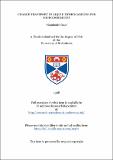Files in this item
Charge transport in liquid hydrocarbons for microdosimetry
Item metadata
| dc.contributor.advisor | Watt, D. E. | |
| dc.contributor.author | Chaar, Mamdouh | |
| dc.coverage.spatial | 209 p. | en_US |
| dc.date.accessioned | 2018-05-17T10:11:32Z | |
| dc.date.available | 2018-05-17T10:11:32Z | |
| dc.date.issued | 1998-06 | |
| dc.identifier.uri | https://hdl.handle.net/10023/13367 | |
| dc.description.abstract | During the last two decades there has been growing interest in the application of organic dielectric liquids for dosimetry of ionizing radiations. The main problem associated with the liquid application in radiation detectors has been the difficulty in securing saturation charge collection and controlled charge multiplication to permit operation in the ionization chamber and proportional counter modes. In an attempt to understand better the fundamental mechanisms involved in the limitation to charge collection an extensive review has been made of the published theoretical and experimental research. The theoretical work attributes the unattainability of saturation charge collection to losses caused by different types of recombination depending on the initial separation of ions liberated and on the magnitude of the applied electric field. None of the presented theories is found to be fully consistent with the reported experimental results obtained for a range of different di-electric liquids, especially in high field regions. Liquid hydrocarbons, especially those characterised by high charge mobility and high yield of ions, have been widely investigated experimentally to explore the mechanisms responsible. The experimental measurements are found to be strongly dependent on: the purity of the liquids, their chemical structure, the type of materials used for the electrodes in contact with the liquid and on the temperature. These conclusions reflect inadequacies both in the theoretical knowledge of charge transport in liquids and in the practical difficulties of measurement which indicate the need for more detailed experimental investigation. The origin of the natural intrinsic dark current in liquids is found to be due to the presence of impurities; the effect of cosmic-ray interactions; and the presence of radioactivity in the construction materials of the detector. Upon application of high electric fields other factors such as electron emission, molecular dissociation and field ionization become significant. The extensive range of results reported on transport properties (mobility, free ion-yield, conduction band energy, di-electric strength, and theoretical W-values) of charge earners in liquid hydrocarbons and liquified rare-gases, and their dependence on the electric field and temperature have been compiled into tabulated form in appendix B to provide a ready reference. New experimental work, aimed at assessing the role and the key factors involved, was conducted with two separate ionization chambers filled with liquid tetramethylsilane (TMS). Information was obtained on the dependence of the current-field characteristic, for the dark and ionization currents, on various parameters such as purity, electrode separation, surface asperities, electrode construction material, and the charge collection area. For the ionization current, the dependence on the radiation intensity, produced with a 4 mCi source of 57Co of y-rays, was also measured. Liquid purity was confirmed to be very important. Chemical and electrical purification, could lead to orders of magnitude reduction in the background dark current. Tests, made to assess the efficiency of ion collection in liquid TMS, indicated the need for much larger, and more uniform, electric fields. These were achieved by fitting electrodes made from tissue-equivalent plastic. The improved surface smoothness of the latter was found to improve the current-to-noise ratio by a factor of 2-3 orders of magnitude. From the results of the present investigation at fields ? 500 kV/cm it was concluded that the saturation collection of charge was attainable. Limitation to achieving saturation is discussed in terms of charge multiplication produced inside localised gas bubbles on the electrode surfaces. Field induced polarization of liquid molecules could be a contributing factor at high fields. There appears to be realistic prospects of achieving saturation collection of charge, and possibly proportional multiplication, by appropriate design using advanced technology to ensure ultra-smooth surfaces and uniform electric fields. | en_US |
| dc.language.iso | en | en_US |
| dc.publisher | University of St Andrews | |
| dc.subject.lcc | RA1231.R2C2 | |
| dc.subject.lcsh | Ionizing radiation--Toxicology | |
| dc.title | Charge transport in liquid hydrocarbons for microdosimetry | en_US |
| dc.type | Thesis | en_US |
| dc.contributor.sponsor | Government of Syria | en_US |
| dc.type.qualificationlevel | Doctoral | en_US |
| dc.type.qualificationname | PhD Doctor of Philosophy | en_US |
| dc.publisher.institution | The University of St Andrews | en_US |
This item appears in the following Collection(s)
Items in the St Andrews Research Repository are protected by copyright, with all rights reserved, unless otherwise indicated.

